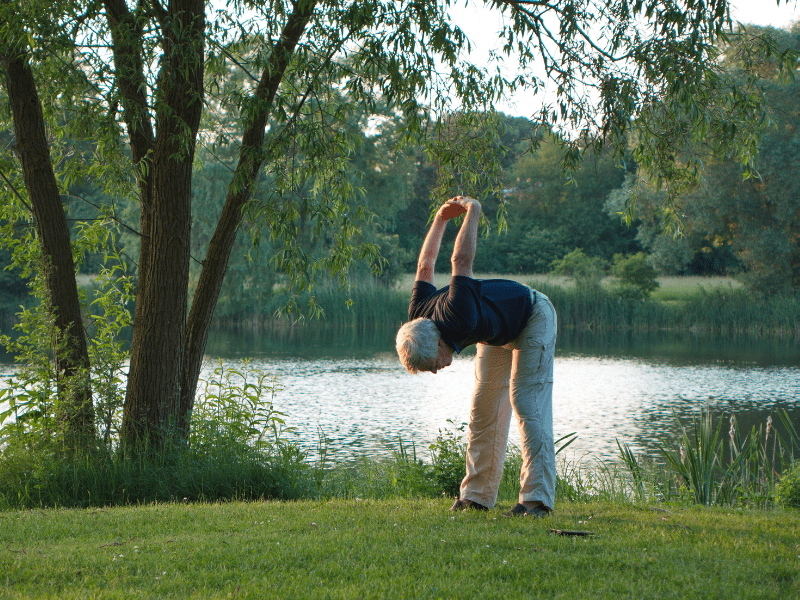Understanding the Importance of Mobility Exercises for Overall Fitness
Maintaining a healthy and active lifestyle is crucial for our overall well-being. When it comes to fitness, many individuals focus primarily on strength training or cardiovascular exercises. However, one aspect that often gets overlooked is mobility exercises. These exercises play a vital role in enhancing our physical capabilities and promoting functional movement.
Mobility exercises are designed to improve the range of motion and flexibility in our joints. They target specific areas of the body, such as hips, shoulders, spine, and ankles, to optimize their mobility and function. By incorporating mobility workouts into our fitness routine, we can enhance our performance in various activities while reducing the risk of injuries.

Flexibility exercises are an integral part of mobility training. They aim to increase muscle elasticity and joint flexibility, allowing us to move more freely without restrictions or discomfort. When combined with strength training and cardiovascular workouts, mobility exercises contribute to a well-rounded fitness regimen.
Functional training is another key benefit of incorporating mobility exercises into our routine. These workouts focus on movements that mimic real-life activities or sports-specific actions. By improving joint mobility through targeted exercises, we can enhance our ability to perform everyday tasks with ease while also excelling in sports or recreational activities.
In this section, we will explore the importance of mobility exercises for overall fitness in more detail. We will discuss various joint mobility techniques and flexibility exercises that can be incorporated into your workout routine. Whether you are an athlete looking to improve performance or someone seeking better functional movement in daily life, understanding the significance of mobility training is essential for achieving optimal physical health and wellness.
Table of Contents
Enhancing Physical Well-Being: The Benefits of Incorporating Mobility Exercises
Incorporating mobility exercises into your fitness routine can bring numerous benefits to your overall physical well-being. These exercises specifically target improving flexibility and increasing range of motion in your joints, helping you move more freely and with ease.
One of the key advantages of incorporating mobility exercises is their ability to prevent injuries. By enhancing the flexibility of your muscles and joints, you reduce the risk of strains, sprains, and other common fitness-related injuries. This is especially important for athletes or individuals who engage in regular physical activity.
Moreover, mobility exercises can greatly enhance athletic performance. When your body has a greater range of motion, you can perform movements more efficiently and effectively. This can lead to improved speed, agility, and power in various sports or physical activities.
Another benefit of incorporating mobility exercises is their ability to reduce muscle imbalances. Imbalances occur when certain muscles become tight or weak compared to their opposing counterparts. These imbalances can lead to poor posture, decreased performance, and increased risk of injury. By focusing on mobility exercises that target specific muscle groups, you can address these imbalances and promote better overall muscular balance.
Overall, integrating mobility exercises into your fitness routine offers a wide array of benefits including improved flexibility, increased range of motion, injury prevention, enhanced athletic performance, and reduced muscle imbalances. Whether you are an athlete or simply looking to improve your overall physical health, incorporating these exercises can have a positive impact on your fitness journey.

Maintaining mobility is crucial for a well-rounded full-body workout. Incorporating specific exercises that target different areas of the body can help improve flexibility, prevent injuries, and enhance overall performance. In this section, we will explore the top five essential mobility exercises for a comprehensive workout.
- Shoulder Mobility Exercises: Strong and mobile shoulders are essential for proper posture and upper body strength. Exercises like shoulder circles, arm swings, and wall slides can help improve range of motion in the shoulder joint and alleviate tension in the upper back.
- Hip Mobility Exercises: The hips play a significant role in various movements, including squats, lunges, and running. Incorporating exercises such as hip circles, hip openers, and deep squats can enhance hip flexibility and stability while reducing the risk of lower back pain.
- Spine Mobility Exercises: A flexible spine is crucial for maintaining good posture and preventing back pain. Exercises like cat-cow stretches, spinal twists, and seated forward bends can promote spinal mobility by stretching the muscles along the spine and improving overall flexibility.
- Ankle Mobility Exercises: Strong ankles are essential for stability during activities such as walking, running, or jumping. Ankle circles, calf raises with ankle dorsiflexion focus on improving ankle range of motion while strengthening the surrounding muscles to prevent ankle sprains or strains.
- Integrated Full-Body Movements: In addition to targeted exercises for specific areas of mobility concern, incorporating integrated full-body movements like yoga flows or dynamic stretching routines can provide an all-encompassing approach to enhancing overall mobility throughout the body.
Remember to always warm up before performing any exercise routine and listen to your body’s limitations when practicing these mobility exercises. By incorporating these top five essential mobility exercises into your workout regimen regularly, you can improve your overall flexibility and ensure a well-rounded full-body fitness routine
Optimizing Fitness Gains: The Synergy of Resistance Training and Mobility Exercises
Incorporating resistance training with mobility exercises can lead to optimal results in improving overall strength, flexibility, and range of motion. One effective approach is to combine mobilization with movement exercises (MWM) with resistance band workouts for mobility training.
Mobilization with movement exercises involve using specific movements and joint mobilizations to improve joint mechanics and reduce pain. These exercises are often performed in a controlled manner, targeting specific areas of the body that may be restricted or lacking mobility.
Resistance band workouts, on the other hand, utilize elastic bands of varying resistance levels to provide added resistance during exercises. These bands can be easily incorporated into mobility training routines to enhance muscle activation and increase the challenge for different muscle groups.
By combining these two approaches, individuals can experience a comprehensive workout that targets both strength and mobility. This combination allows for improved joint stability while also increasing muscle strength and flexibility.

Resistance band workouts can be tailored to target specific areas of the body that require enhanced mobility. For example, incorporating resistance bands into shoulder stretches or hip-opening exercises can help improve range of motion in those areas.
It is important to note that when incorporating resistance training with mobility exercises, proper form and technique should always be emphasized. Gradually increasing the intensity and difficulty level over time will help prevent injuries while maximizing results.
Integrating mobilization with movement exercises (MWM) along with resistance band workouts for mobility training offers a well-rounded approach to achieving optimal results in terms of strength, flexibility, and range of motion. By incorporating these techniques into your fitness routine, you can enhance your overall physical performance and promote long-term joint health.
- Mobility Workouts for Specific Goals: From Injury Prevention to Performance Enhancement
- Mobility exercises for injury prevention: Focus on areas prone to injury in your sport or activity.
- Mobility workouts for increased strength: Combine resistance training with dynamic stretching movements.
- Mobility routines for functional fitness: Incorporate multi-joint movements that mimic daily activities.
- Mobility exercises for athletes: Target sport-specific movements and muscle groups.
Proper form and technique are crucial when it comes to performing mobility exercises effectively and safely. By following these tips, you can maximize the benefits of your mobility routine while minimizing the risk of injury.
First and foremost, it is important to maintain proper alignment throughout each exercise. This means keeping a neutral spine, engaging your core muscles, and avoiding excessive rounding or arching of the back. Pay attention to your posture and make adjustments as needed to ensure that you are in a stable position.
Another key aspect of proper form is to avoid rushing through the movements. Take your time and focus on performing each exercise with control and precision. This will allow you to fully engage the targeted muscles and improve your range of motion over time.
Additionally, paying attention to your breathing during mobility exercises is essential. Proper breathing technique can help enhance performance and reduce tension in the body. As a general rule, inhale deeply through your nose before initiating the movement, and exhale slowly through your mouth as you complete the motion. This rhythmic breathing pattern promotes relaxation, oxygenates the muscles, and helps maintain focus.
Lastly, be mindful of common mistakes that people often make during mobility exercises. These include using momentum instead of muscle control, neglecting proper warm-up before starting the routine, or pushing beyond your current range of motion too quickly. By being aware of these pitfalls, you can avoid unnecessary strain on your joints or muscles.
By following these tips for proper form and technique during mobility exercises, you can optimize their effectiveness while reducing the risk of injury. Remember to listen to your body’s cues and adjust accordingly if something feels uncomfortable or painful. With consistent practice and attention to detail, you will reap the full benefits of incorporating mobility exercises into your fitness routine.
Prioritizing Long-Term Health: The Crucial Role of Mobility Exercises in Your Fitness Routine
In conclusion, incorporating mobility exercises into your fitness routine is crucial for achieving long-term health and performance benefits. These exercises focus on improving the range of motion and flexibility in your joints and muscles, which are essential for maintaining proper posture, preventing injuries, and optimizing athletic performance.
By regularly performing mobility exercises, you can enhance your overall physical function and reduce the risk of developing musculoskeletal imbalances or limitations. This is especially important as we age since mobility tends to naturally decline over time. By prioritizing these exercises now, you can preserve your mobility well into the future.
Additionally, incorporating mobility exercises into your fitness routine can also improve your athletic performance. By increasing joint range of motion and flexibility, you can enhance movement efficiency and power output during various activities or sports. This can lead to improved agility, speed, strength gains, and overall athletic prowess.

It’s important to note that while other aspects of fitness such as strength training or cardiovascular exercise are important too; neglecting mobility exercises may limit your progress in these areas. Without adequate mobility, you may be more prone to injuries or experience decreased performance due to restricted movement patterns.
To make mobility exercises a priority in your fitness routine:
- Start by identifying areas of limited range of motion or tightness in your body.
- Incorporate specific stretches or movements that target those areas.
- Gradually increase the intensity or difficulty level of the exercises over time.
- Aim for consistency by including mobility work in every workout session.
- Seek guidance from a qualified professional such as a personal trainer or physical therapist if needed.
By making mobility exercises a regular part of your fitness routine today, you’ll reap the long-term benefits of improved health and enhanced physical performance tomorrow and beyond.

